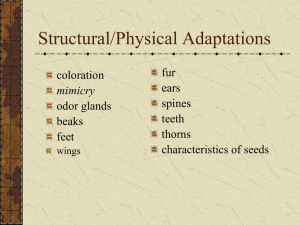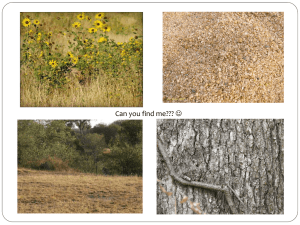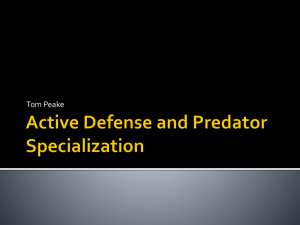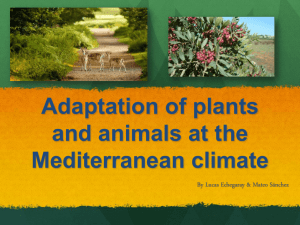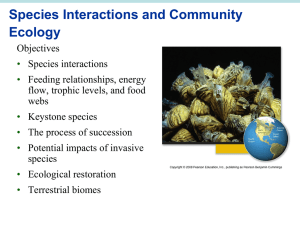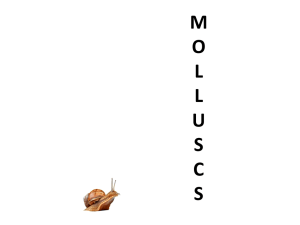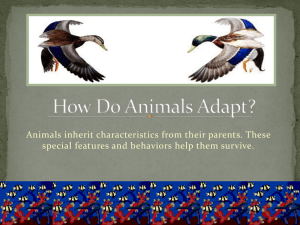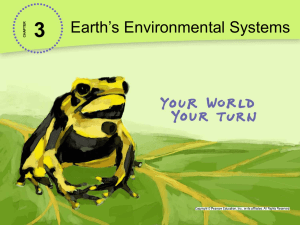Predator and Prey of the Chihuahuan Desert
advertisement
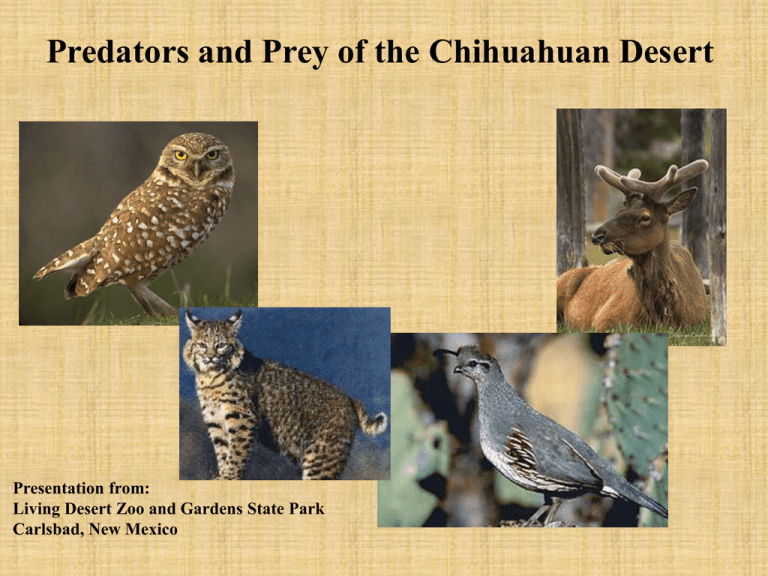
Predators and Prey of the Chihuahuan Desert Presentation from: Living Desert Zoo and Gardens State Park Carlsbad, New Mexico Predators Predators are animals that eat other animals for food. Barn Owl Mountain Lion Predators’ Eye Position Predators’ eyes face forward so they can see the animals they are chasing. This allows them to focus their vision on just the prey. They have great depth perception, so they can see how close or far away the prey is. Predators have their best vision in their binocular area because they are seeing the prey with both eyes. They don’t see the prey as well in their monocular areas because they can only see with the eye on that particular side. Notice how these predators’ eyes face forward to give them a clear view of their prey. Burrowing Owl Skull Mountain Lion Mexican Grey Wolves Predators’ Feet Predators usually have sharp claws that they use to hold on to their prey while they are killing it. Wolf Feet Mountain Lion Feet Predators’ Teeth Predators are carnivores (mostly meat eaters) or omnivores (plant and animal eaters), so they have sharp, pointed teeth for grabbing and cutting their food. They use their long, sharp canine teeth to kill, hold, and tear the meat. They use their sharp, pointed back premolar and molar teeth to cut the food into chunks that are small enough to swallow. Predators don’t usually chew the meat completely. The meat is swallowed whole or in chunks. Predators are carnivores (animals that eat meat) or omnivores (animals that eat meat and plants). Predators have: • sharp teeth • sharp claws • eyes that look forward (binocular vision) to help them judge the distance to the prey This predator has sharp teeth and eyes that face forward. Gray Fox Prey Prey are animals that are eaten by predators. Mule Deer Desert Cottontail Rabbit Preys’ Eyes Preys’ eyes are located at the sides of the head, so they have good side and rear vision. Since prey spend most of their time eating grass and leaves, it is important for them to see to the side and rear without moving their heads to allow them to look out for predators and to eat at the same time. Prey have almost 360-degree vision. Prey have monocular vision, meaning they use each eye separately. This allows them to see two different objects on opposite sides of their bodies at the same time. Notice how these preys’ eyes are located on the sides of their heads, so they can see if predators are approaching them. Black -chinned Hummingbird Desert Cottontail Rabbit Mule Deer Preys’ Feet Prey that are ungulates (hoofed animals) have hooves attached to long slender legs that allow them to run quickly away from predators. Other prey animals have special adaptations to help them get away from their predators. This rabbit’s feet allows it to bound quickly away from its predators. This hummingbird uses its wings to fly away from predators. Deer Hoof Preys’ Teeth Herbivores (plant eaters) have flat teeth that they use to grind tough plant materials. Deer Deer basically have two types of teeth. The front teeth, or incisors, are used for cutting the food. The back teeth, or premolars and molars - are used for chewing and grinding the food. Between the incisors and molars is an open space along the jaw that has no teeth. Omnivores’ Teeth Many animals, including humans, are omnivores. Because they eat both meat and plant foods they have some teeth (incisors and canines) that are used to cut, bite, and tear meat and other teeth (premolars and molars) to chew and grind fruits, vegetables and grains. Herbivores are always prey. They: •have flat teeth for chewing plants • have feet for running • have eyes that look to the side, so they can see a wide range without turning their heads. These animal skulls have large flat molars for chewing plant foods. Their eyes are located on the sides of their heads so they can watch for predators. Deer Porcupine Predator or Prey? By looking at an animal’s feet, eye position, and teeth a person can usually tell if an animal is a predator or prey. See if you can determine which of these animals are predators and which are prey. Remember to look at their feet and eye positions. Mountain Lion Kangaroo Rat Bobcat Javelina The Predator Becomes the Prey Some animals can be both predators and prey. For example, a Texas horned lizard is a predator when it eats ants, termites, beetles, and grasshoppers. It is also a prey when it is eaten by snakes, bobcats, roadrunners and other birds such as hawks and loggerhead shrikes. The horned lizard is a predator when it eat ants and other insects. A horned lizard is a prey when it is eaten by birds, snakes, wolves, bobcats, and coyotes. The animals that are primary consumers and the animals that are tertiary consumers are easy to identify as prey or predators. The primary consumers are the ones that eat plants and become prey to the secondary consumers. The tertiary consumers are the animals at the top of the energy pyramid. They will eat both primary and secondary consumers. Because they are at the top of the pyramid, they don’t usually get eaten by other animals, so they are only predators. The animals that are at the secondary consumer level are the ones that can be both predators and prey. These animals are predators. They are at the top of their food chain and are not usually eaten by other animals. Often these animals can be both predators and prey. These animals are only prey.

